Characteristics and Mechanisms of CO2 Flooding with Varying Degrees of Miscibility in Reservoirs Composed of Low-Permeability Conglomerate Formations
Abstract
1. Introduction
2. Experimental Materials, Equipment, and Methods
2.1. Sample Preparation
2.2. Slim Tube Experiment
2.3. CO2 Displacement Experiment of Long Core
2.4. Online Nuclear Magnetic Resonance Experiment
3. Experimental Results and Discussion
3.1. Characteristics of CO2 Flooding with Different Miscibility Levels at Slim Tube Scale
3.2. Characteristics of CO2 Flooding with Different Miscibility Levels at Core Scale
3.2.1. Characteristics of CO2 Immiscible Flooding
3.2.2. Characteristics of CO2 Near-Miscible Flooding
3.2.3. Characteristics of CO2 Miscible Flooding
3.3. Analysis of Composition and Oil–Water Interfacial Tension Changes
3.4. Analysis of Pore Movement at Miscible Pressure
4. Conclusions
- (1)
- In the case of slim tubes, breakthrough time is closely proportional to pressure changes. When the phase goes from immiscible to almost miscible, the recovery rate changes qualitatively. The specific manifestation is that after CO2 enters the near-miscible phase, it can effectively delay the time of gas release and increase the recovery effect to over 80 percent.
- (2)
- At the core size, as the pressure reaches the near-miscible phase, the displacement state might transition from being “piston-like” during the immiscible phase to the “miscible phase”. This can effectively lower interfacial tension and extraction, efficiently prolonging the gas duration. When comparing with an immiscible phase, a virtually miscible phase can enhance the recovery impact by 9.27%, and a completely miscible phase can improve it by 18.72%.
- (3)
- The variations in the constituents of the displacement products with varying levels of compatibility are mostly focused on the stages of high production and gas breakthrough. During the high-yield stage, an increase in miscibility leads to a higher proportion of heavy components in the resulting product. This means that improved miscibility can effectively enhance the ability to extract oil. During the gas breakthrough stage, an increase in miscibility leads to a higher proportion of light components in the produced material. This means that after gas breakthrough, oil is primarily produced through the combined actions of miscibility and carrying.
- (4)
- Changes in oil saturation in the core primarily occur prior to gas breakthrough. CO2 microscopic oil flooding preferentially progresses along large pores and fine flow channels, and the remaining oil after gas flooding is primarily distributed in the big pores at the margins. CO2 miscible flooding can use crude oil in small and medium pores throughout the middle and late stages, lowering the pore utilization limit to 0.3 μm.
Author Contributions
Funding
Data Availability Statement
Conflicts of Interest
References
- Dziejarski, B.; Krzyżyńska, R.; Andersson, K. Current status of carbon capture, utilization, and storage technologies in the global economy: A survey of technical assessment. Fuel 2023, 342, 127776. [Google Scholar] [CrossRef]
- Nagireddi, S.; Agarwal, J.R.; Vedapuri, D. Carbon Dioxide Capture, Utilization, and Sequestration: Current Status, Challenges, and Future Prospects for Global Decarbonization. ACS Eng. Au. 2024, 4, 22–48. [Google Scholar] [CrossRef]
- Dou, L.; Sun, L.; Lyu, W.; Wang, M.; Gao, F.; Gao, M.; Jiang, H. Trend of global carbon dioxide capture, utilization and storage industry and challenges and countermeasures in China. Pet. Explor. Dev. 2023, 50, 1246–1260. [Google Scholar] [CrossRef]
- Wei, Y.; Kang, J.; Liu, L.; Li, Q.; Wang, P.; Hou, J.; Liang, Q.; Liao, H.; Huang, S.; Yu, B. A proposed global layout of carbon capture and storage in line with a 2 C climate target. Nat. Clim. Chang. 2021, 11, 112–118. [Google Scholar] [CrossRef]
- Yang, L.; Rui, W.; Qingmin, Z.; Xin, F. Status and prospects for CO2 capture, utilization and storage technology in China. Pet. Sci. Bull. 2023, 04, 391–397. [Google Scholar]
- Song, X.; Wang, F.; Ma, D.; Gao, M.; Zhang, Y. Progress and prospect of carbon dioxide capture, utilization and storage in CNPC oilfields. Pet. Explor. Dev. 2023, 50, 229–244. [Google Scholar]
- Wilberforce, T.; Olabi, A.G.; Sayed, E.T.; Elsaid, K.; Abdelkareem, M.A. Progress in carbon capture technologies. Sci. Total Environ. 2021, 761, 143203. [Google Scholar] [CrossRef]
- Friedlingstein, P.; O’Sullivan, M.; Jones, M.W.; Andrew, R.M.; Hauck, J.; Olsen, A.; Peters, G.P.; Peters, W.; Pongratz, J.; Sitch, S.; et al. Global carbon budget 2020. Earth Syst. Sci. Data 2020, 12, 3269–3340. [Google Scholar] [CrossRef]
- Bruce, H.L.; Li, C.; Wei, N. CO2-EOR in China: A comparative review. Int. J. Greenh. Gas Control 2020, 103, 103173. [Google Scholar]
- Yan, L.I.; Di, Z.; Xiaoyi, F.; Jintong, Z. EOR of CO2 flooding in low-permeability sandy conglomerate reservoirs. Xinjiang Pet. Geol. 2022, 43, 136. [Google Scholar]
- Kumar, N.; Sampaio, M.A.; Ojha, K.; Hoteit, H.; Mandal, A. Fundamental aspects, mechanisms and emerging possibilities of CO2 miscible flooding in enhanced oil recovery: A review. Fuel 2022, 330, 125633. [Google Scholar] [CrossRef]
- dos Santos Bastos, L.; da Silva Lins, I.E.; de Tarso Vieira e Rosa, P.; Costa, G.M.N.; de Melo, S.A.B.V. An experimental assessment of seawater alternating near-miscible CO2 for EOR in pre-salt carbonate reservoirs. Geoenergy Sci. Eng. 2023, 230, 212227. [Google Scholar] [CrossRef]
- Chen, H.; Zhang, X.; Chen, Y.; Tang, H.; Mei, Y.; Li, B.; Shen, X. Study on pressure interval of near-miscible flooding by production gas Re-injection in QHD offshore oilfield. J. Petrol. Sci. Eng. 2017, 157, 340–348. [Google Scholar] [CrossRef]
- Alston, R.B.; Kokolis, G.P.; James, C.F. CO2 minimum miscibility pressure: A correlation for impure CO2 streams and live oil systems. Soc. Pet. Eng. J. 1985, 25, 268–274. [Google Scholar] [CrossRef]
- Khosravi, M.; Rostami, B.; Emadi, M.; Roayaei, E. Marangoni flow: An unknown mechanism for oil recovery during near-miscible CO2 injection. J. Pet. Sci. Eng. 2015, 125, 263–268. [Google Scholar] [CrossRef]
- Lee, I.J. Effectiveness of Carbon Dioxide Displacement under Miscible And immiscible Conditions. 1979. Available online: https://www.osti.gov/etdeweb/biblio/6468594 (accessed on 9 May 2024).
- Mogensen, K.; Hood, P.; Lindeloff, N.; Frank, S.; Noman, R. Minimum miscibility pressure investigations for a gas injection EOR project in Al Shaheen field, offshore Qatar. In Proceedings of the SPE Annual Technical Conference and Exhibition, New Orleans, LA, USA, 4–7 October 2009; SPE: London, UK, 2009. [Google Scholar]
- Shakiba, M.; Ayatollahi, S.; Riazi, M. Investigation of oil recovery and CO2 storage during secondary and tertiary injection of carbonated water in an Iranian carbonate oil reservoir. J. Pet. Sci. Eng. 2016, 137, 134–143. [Google Scholar] [CrossRef]
- Yang, X. Influence factors appraisal of slim-tube simulation to determine the minimum miscibility pressure. J. Southwest Pet. Univ. (Sci. Technol. Ed.) 2004, 26, 41. [Google Scholar]
- Guo, R.; Chen, X.; Ma, X.; Ma, J.; Wang, Q.; Chen, L. Analysis of the characteristics and its influencing factors of horizontal movable fluid in the Chang 7 tight reservoir in Longdong area, Ordos basin. Nat. Gas. Geosci. 2018, 29, 665–674. [Google Scholar]
- Wang, X.; Li, H. Experimental study on pore structure of low permeability core with NMR spectra. J. Southwest Pet. Univ. (Sci. Technol. Ed.) 2010, 32, 69. [Google Scholar]
- Yang, X.; Fan, J.; Zhang, Y.; Li, W.; Du, Y.; Yang, R. Microscopic pore structure characteristics of tight limestone reservoirs: New insights from section 1 of the Permian Maokou formation, southeastern Sichuan basin, China. Unconv. Resour. 2022, 2, 31–40. [Google Scholar] [CrossRef]
- Yang, Z.; Zhang, Y.; Li, H.; Zheng, X.; Lei, Q. Application Basis of Nuclear Magnetic Resonance Technology in the Unconventional Reservoirs. Earth Sci. 2017, 42, 1333–1339. [Google Scholar]
- Zhao, Y.; Zhang, Y.; Lei, X.; Zhang, Y.; Song, Y. CO2 flooding enhanced oil recovery evaluated using magnetic resonance imaging technique. Energy 2020, 203, 117878. [Google Scholar] [CrossRef]
- Wang, H.; Lun, Z.; Lv, C.; Lang, D.; Ji, B.; Luo, M.; Pan, W.; Wang, R.; Gong, K. Measurement and visualization of tight rock exposed to CO2 using NMR relaxometry and MRI. Sci. Rep. 2017, 7, 44354. [Google Scholar] [CrossRef] [PubMed]
- Sun, H.; Wang, H.; Lun, Z. Effect of permeability and fractures on oil mobilization of unconventional resources during CO2 EOR using nuclear magnetic resonance. Sci. Rep. 2021, 11, 12660. [Google Scholar] [CrossRef] [PubMed]
- Cao, A.; Li, Z.; Zheng, L.; Bai, H.; Zhu, D.; Li, B. Nuclear magnetic resonance study of CO2 flooding in tight oil reservoirs: Effects of matrix permeability and fracture. Geoenergy Sci. Eng. 2023, 225, 211692. [Google Scholar] [CrossRef]
- Zhang, H.; Wang, Y.; Fang, T.; Wang, W.; Zhao, X.R.; Zhao, H.P.; Wu, J.L.; Wei, G.; Liu, B. First application of new generation NMR T1-T2 logging and interpretation in unconventional reservoirs in China. In Proceedings of the SPE Asia Pacific Oil and Gas Conference and Exhibition, Virtual, 17–19 November 2020; SPE: London, UK, 2020; p. D013S001R002. [Google Scholar]
- Wang, H.; Tian, L.; Chai, X.; Wang, J.; Zhang, K. Effect of pore structure on recovery of CO2 miscible flooding efficiency in low permeability reservoirs. J. Pet. Sci. Eng. 2022, 208, 109305. [Google Scholar] [CrossRef]
- Cui, X.; Zheng, L.; Liu, Z.; Cui, P.; Du, D. Determination of the minimum miscibility pressure of the CO2/oil system based on quantification of the oil droplet volume reduction behavior. Colloids Surf. A Physicochem. Eng. Asp. 2022, 653, 130058. [Google Scholar] [CrossRef]
- Ghorbani, M.; Momeni, A.; Safavi, S.; Gandomkar, A. Modified vanishing interfacial tension (VIT) test for CO2–oil minimum miscibility pressure (MMP) measurement. J. Nat. Gas Sci. Eng. 2014, 20, 92–98. [Google Scholar] [CrossRef]
- Li, X.; Wang, S.; Feng, Q.; Xue, Q. The miscible behaviors of C10H22 (C7H17N)/C3H8 system: Insights from molecular dynamics simulations. Fuel 2020, 279, 118445. [Google Scholar] [CrossRef]
- Zhou, X.; Jiang, Q.; Yuan, Q.; Zhang, L.; Feng, J.; Chu, B.; Zeng, F.; Zhu, G. Determining CO2 diffusion coefficient in heavy oil in bulk phase and in porous media using experimental and mathematical modeling methods. Fuel 2020, 263, 116205. [Google Scholar] [CrossRef]
- Zheng, S.; Yang, D. Experimental and theoretical determination of diffusion coefficients of CO2-heavy oil systems by coupling heat and mass transfer. J. Energy Resour. Technol. 2017, 139, 022901. [Google Scholar] [CrossRef]
- Fayazi, A.; Kantzas, A. Modeling of CO2 diffusion into water-shielded oil at pore scale using moving mesh technique. Chem. Eng. Sci. 2018, 179, 64–72. [Google Scholar] [CrossRef]
- Cai, M.; Su, Y.; Hao, Y.; Guo, Y.; Elsworth, D.; Li, L.; Li, D.; Li, X. Monitoring oil displacement and CO2 trapping in low-permeability media using NMR: A comparison of miscible and immiscible flooding. Fuel 2021, 305, 121606. [Google Scholar] [CrossRef]
- Zhu, C.; Li, Y.; Zhao, Q.; Gong, H.; Sang, Q.; Zou, H.; Dong, M. Experimental study and simulation of CO2 transfer processes in shale oil reservoir. Int. J. Coal Geol. 2018, 191, 24–36. [Google Scholar] [CrossRef]
- Qin, J.; Han, H.; Liu, X. Application and enlightenment of carbon dioxide flooding in the United States of America. Pet. Explor. Dev. 2015, 42, 232–240. [Google Scholar]
- Peng, X.-T.; Lyu, H.-D.; Zhang, X. Interpretation of IPCC AR6 report on carbon capture, utilization and storage (CCUS) technology development. Adv. Clim. Chang. Res. 2022, 18, 580. [Google Scholar]
- Hu, Y.; Hao, M.; Chen, G.; Sun, R.; Li, S. Technologies and practice of CO2 flooding and sequestration in China. Pet. Explor. Dev. 2019, 46, 753–766. [Google Scholar]
- Liu, J.; Zhang, Q.; Lu, W.; Li, G.; Teng, F.; Gao, Z. Research Progress and Industry Development Strategy of Integrated Carbon Capture, Utilization and Storage Technology. J. Beijing Inst. Technol. (Soc. Sci. Ed.) 2023, 25, 40–53. [Google Scholar]
- Wang, Q.; Yang, S.; Han, H.; Wang, L.; Qian, K.; Pang, J. Experimental investigation on the effects of CO2 displacement methods on petrophysical property changes of ultra-low permeability sandstone reservoirs near injection wells. Energies 2019, 12, 327. [Google Scholar] [CrossRef]
- Chen, H. Key Problems and Countermeasures in CO2 Flooding and Storage. Acta Geol. Sin. Engl. Ed. 2023, 97, 858–872. [Google Scholar] [CrossRef]
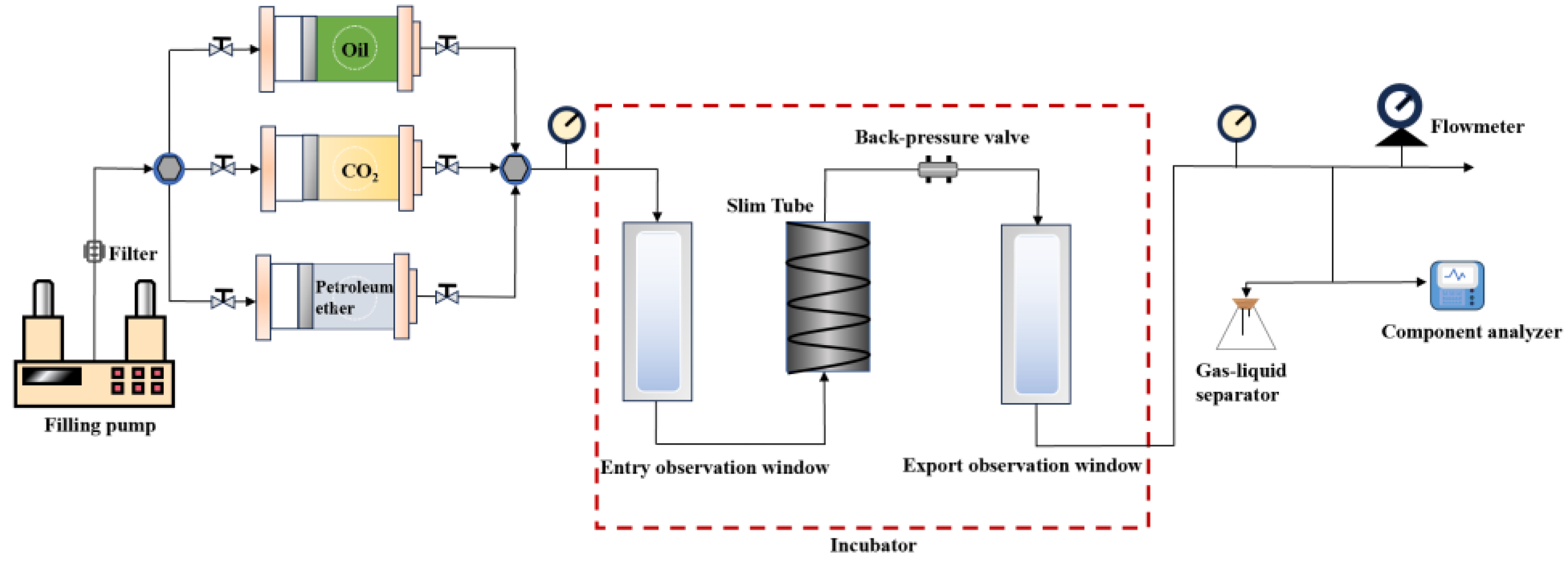



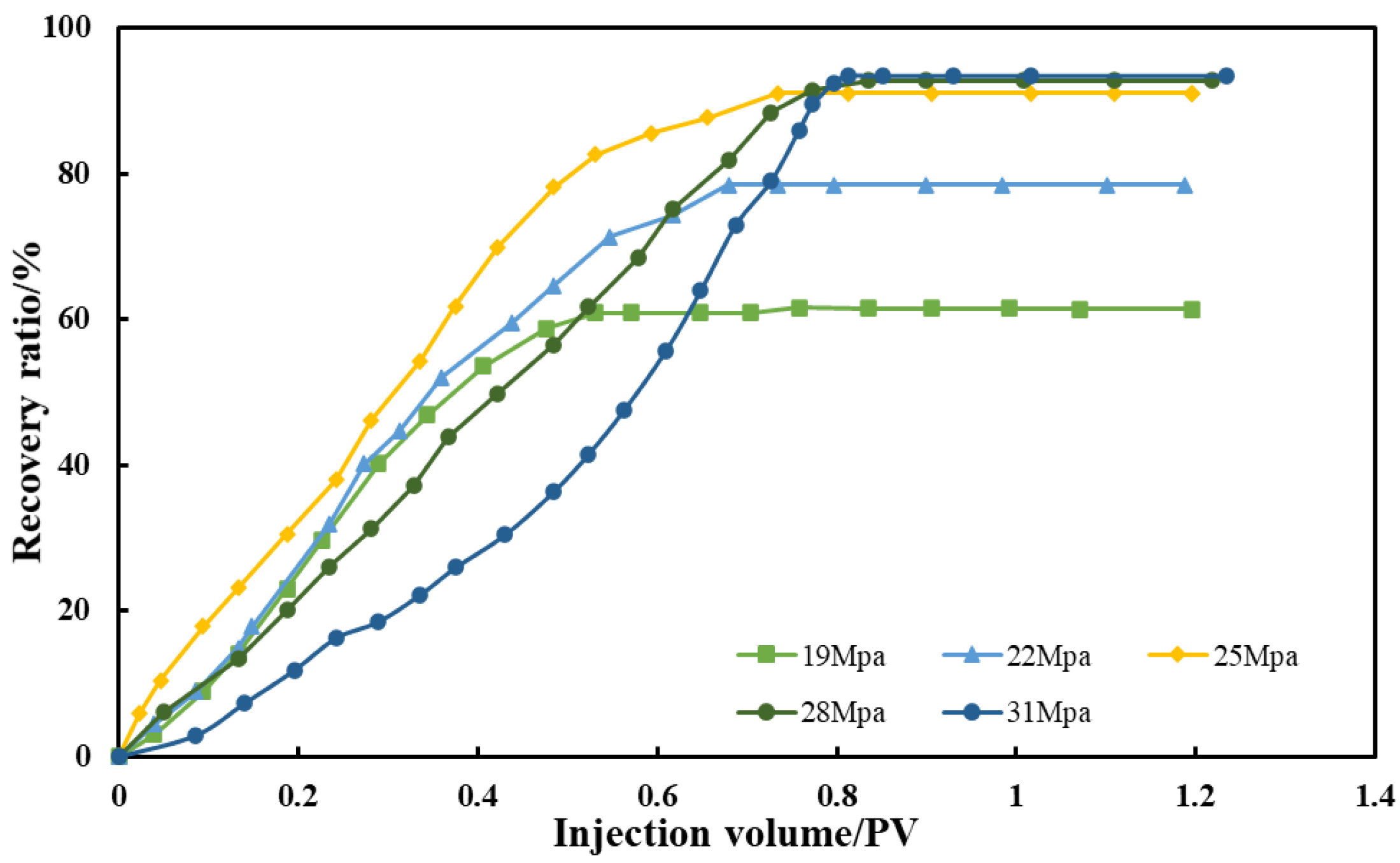

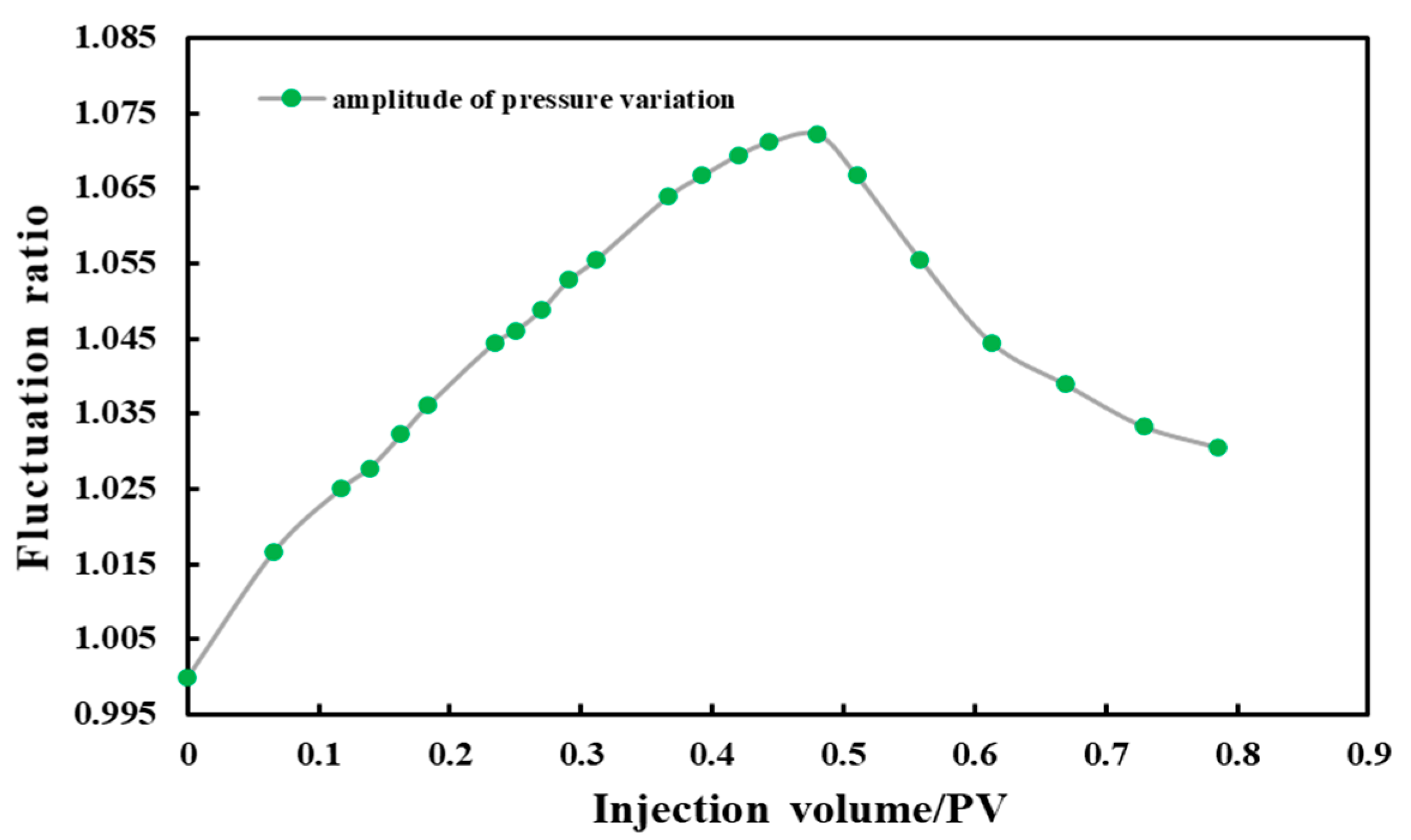
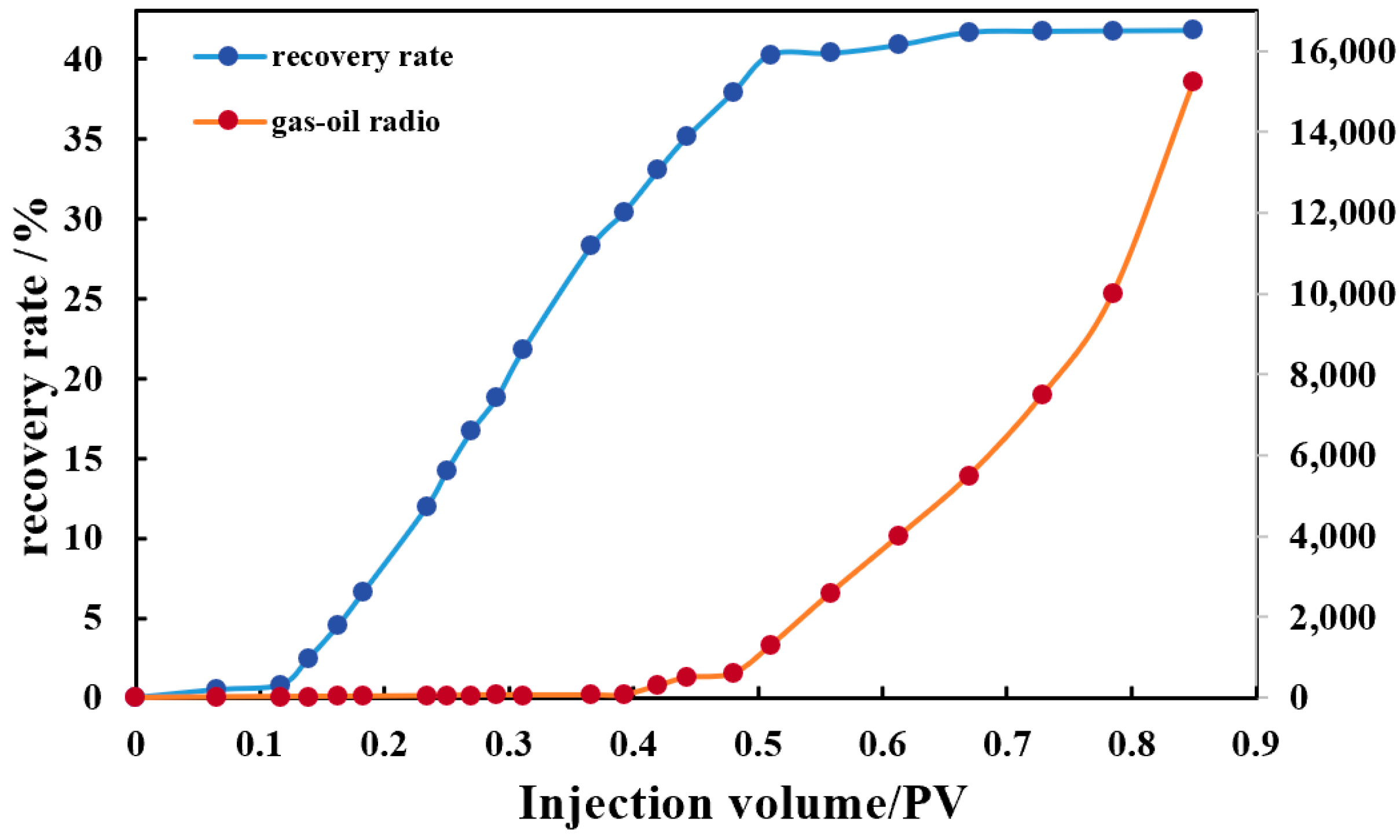
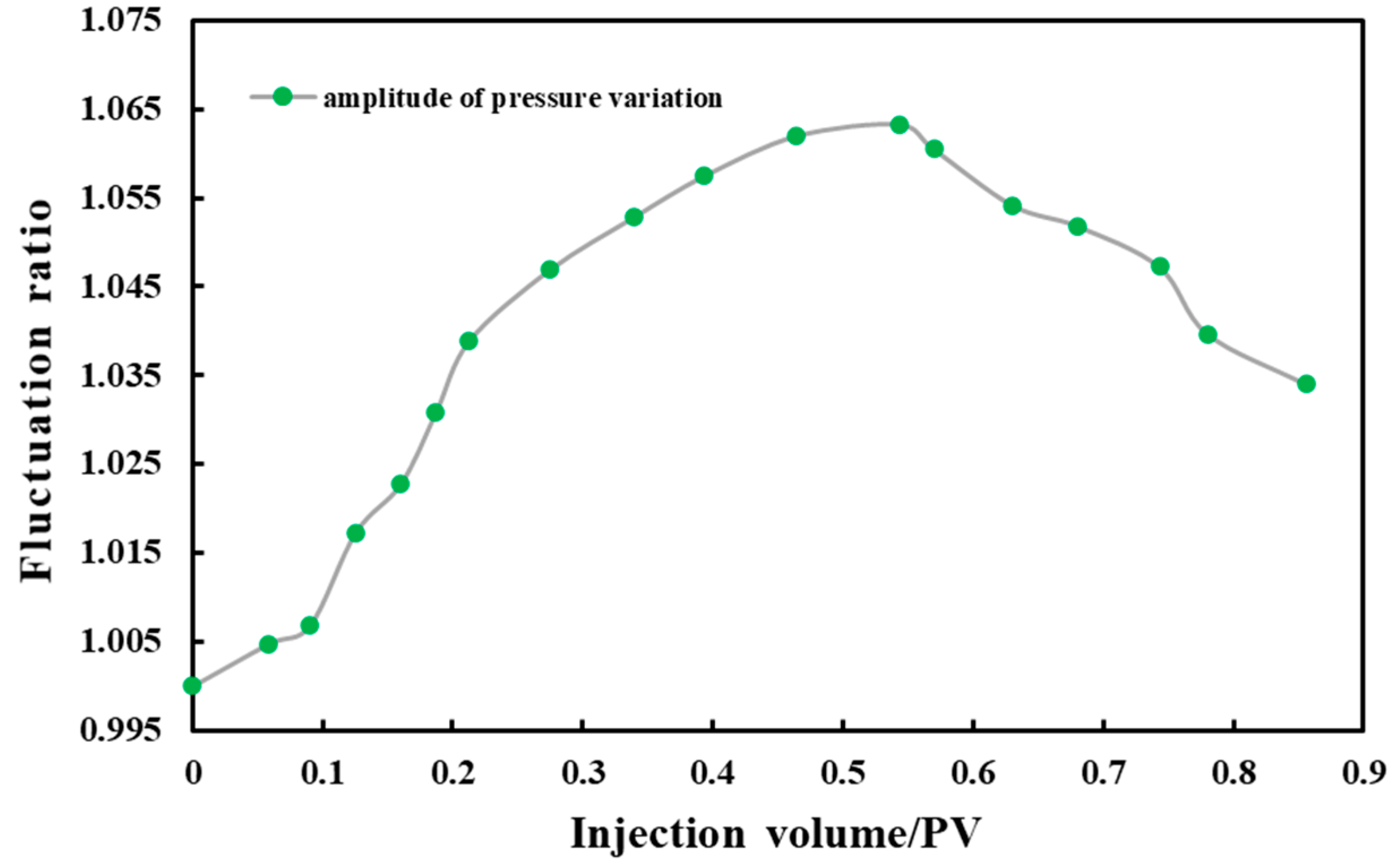
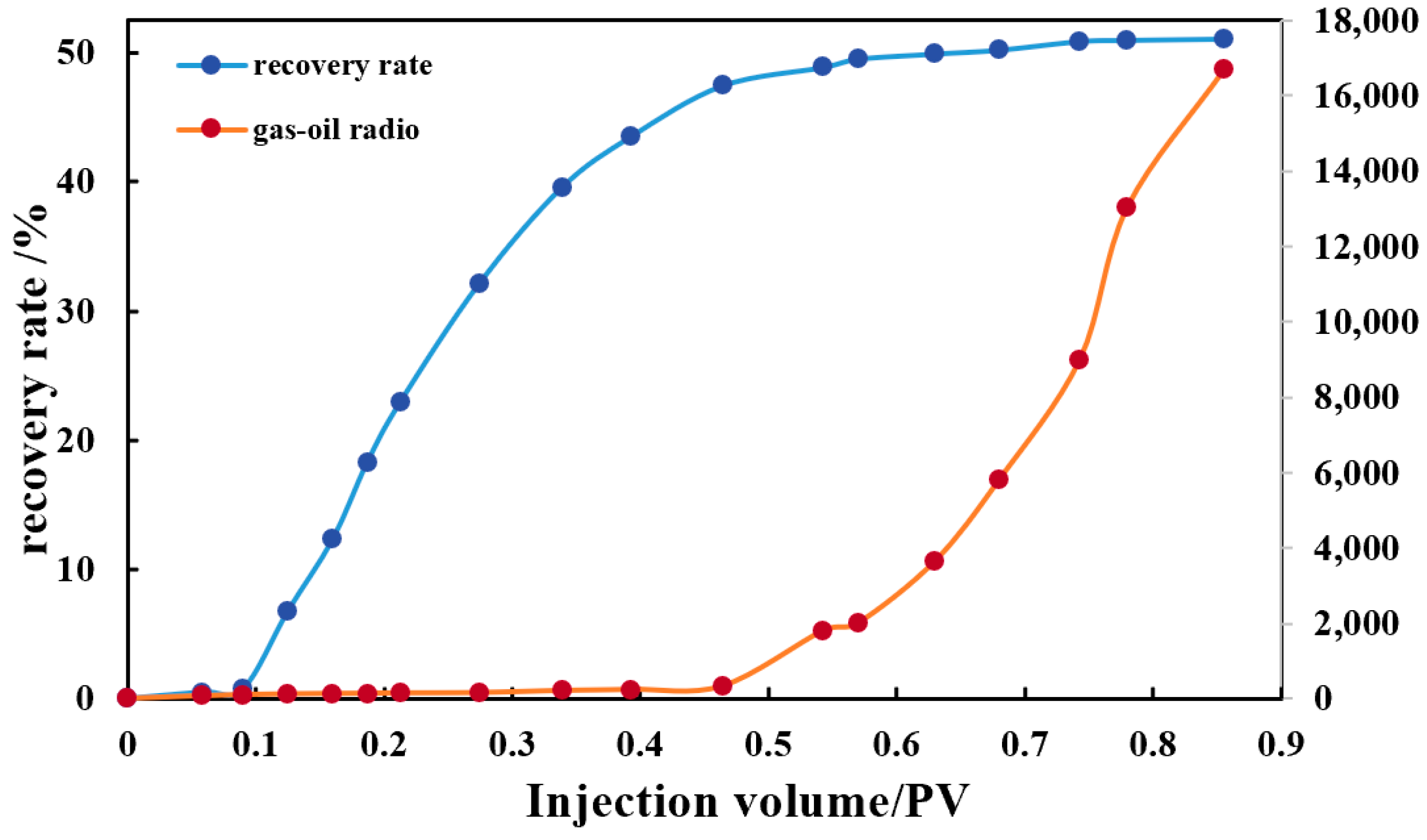
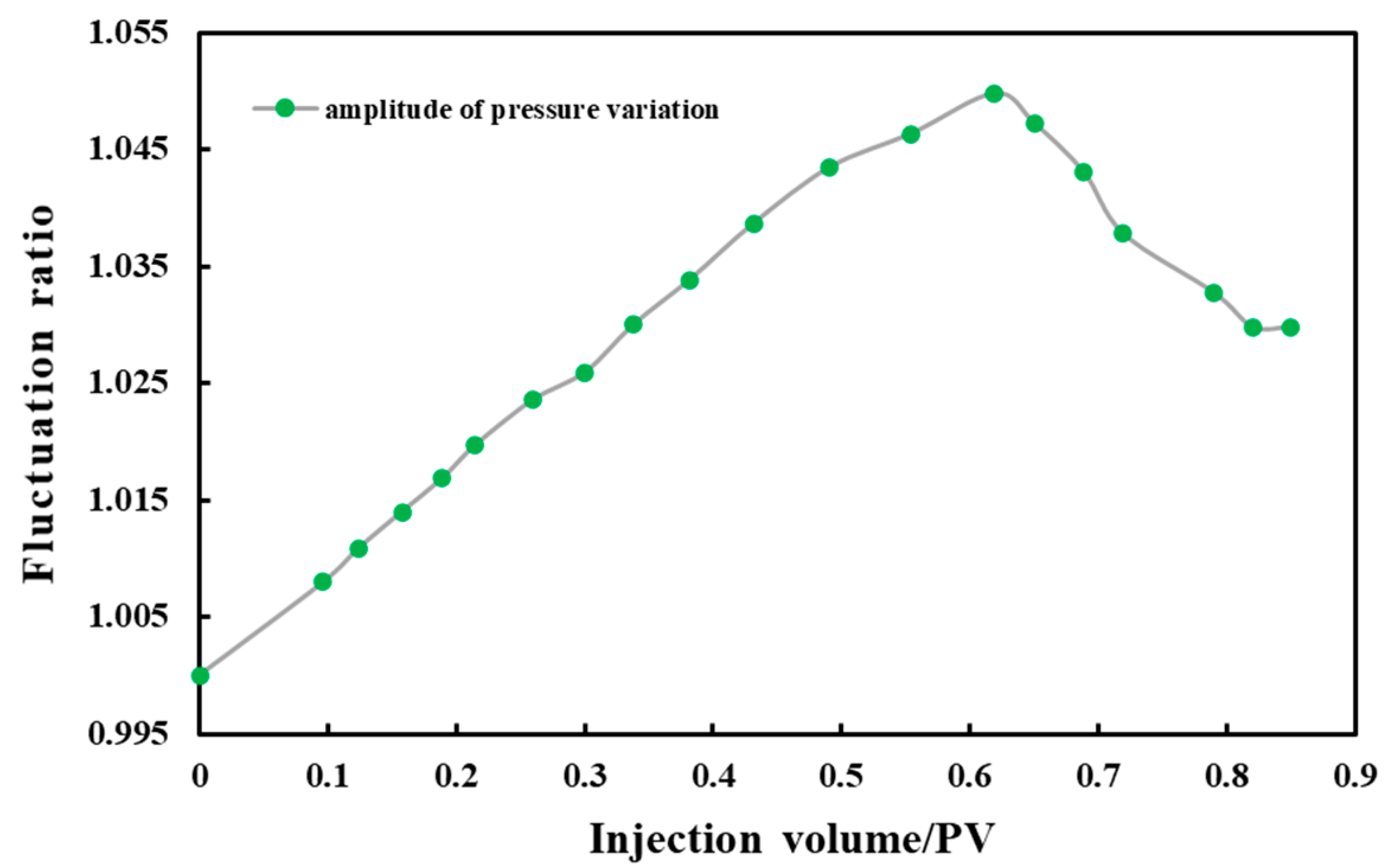


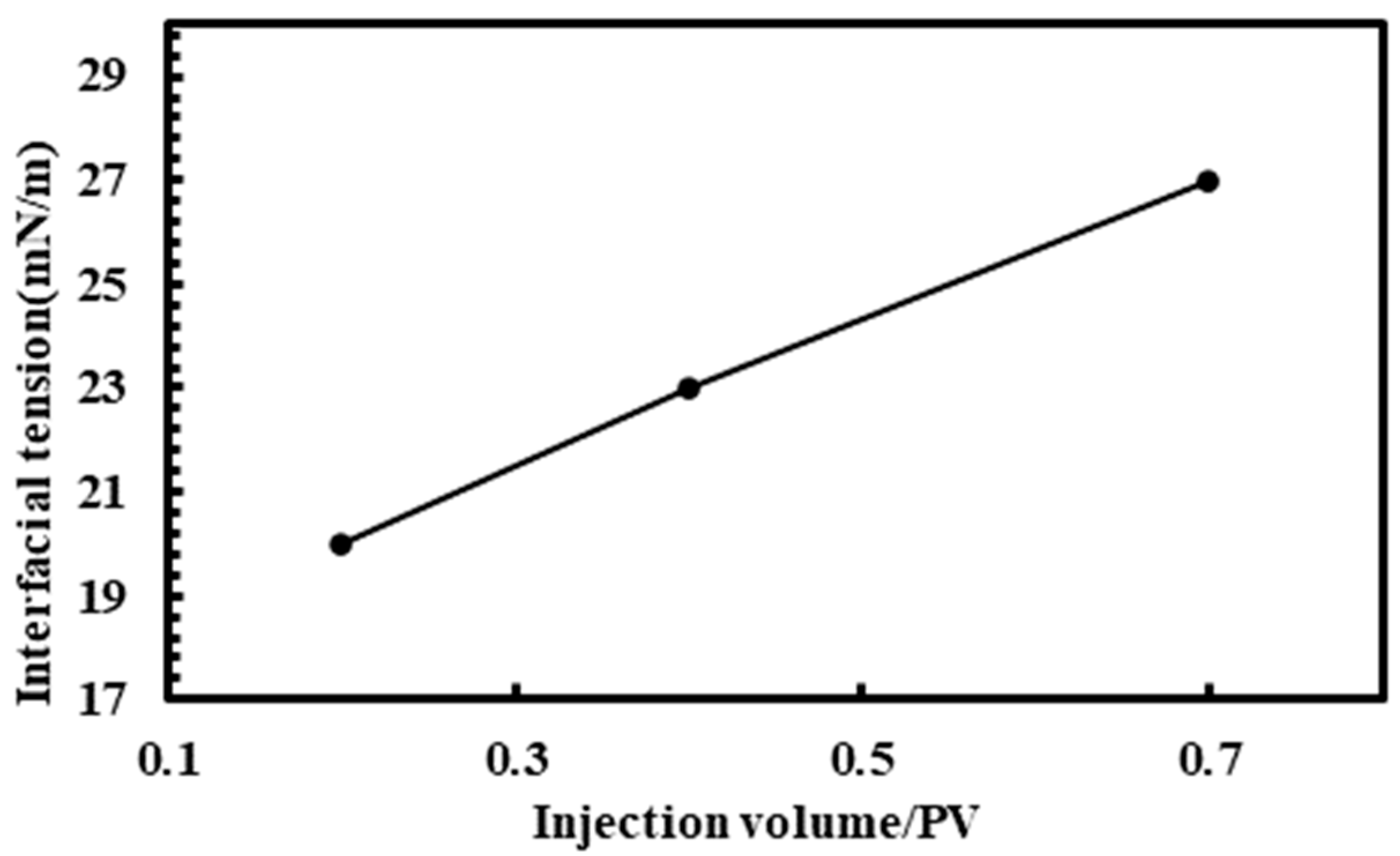

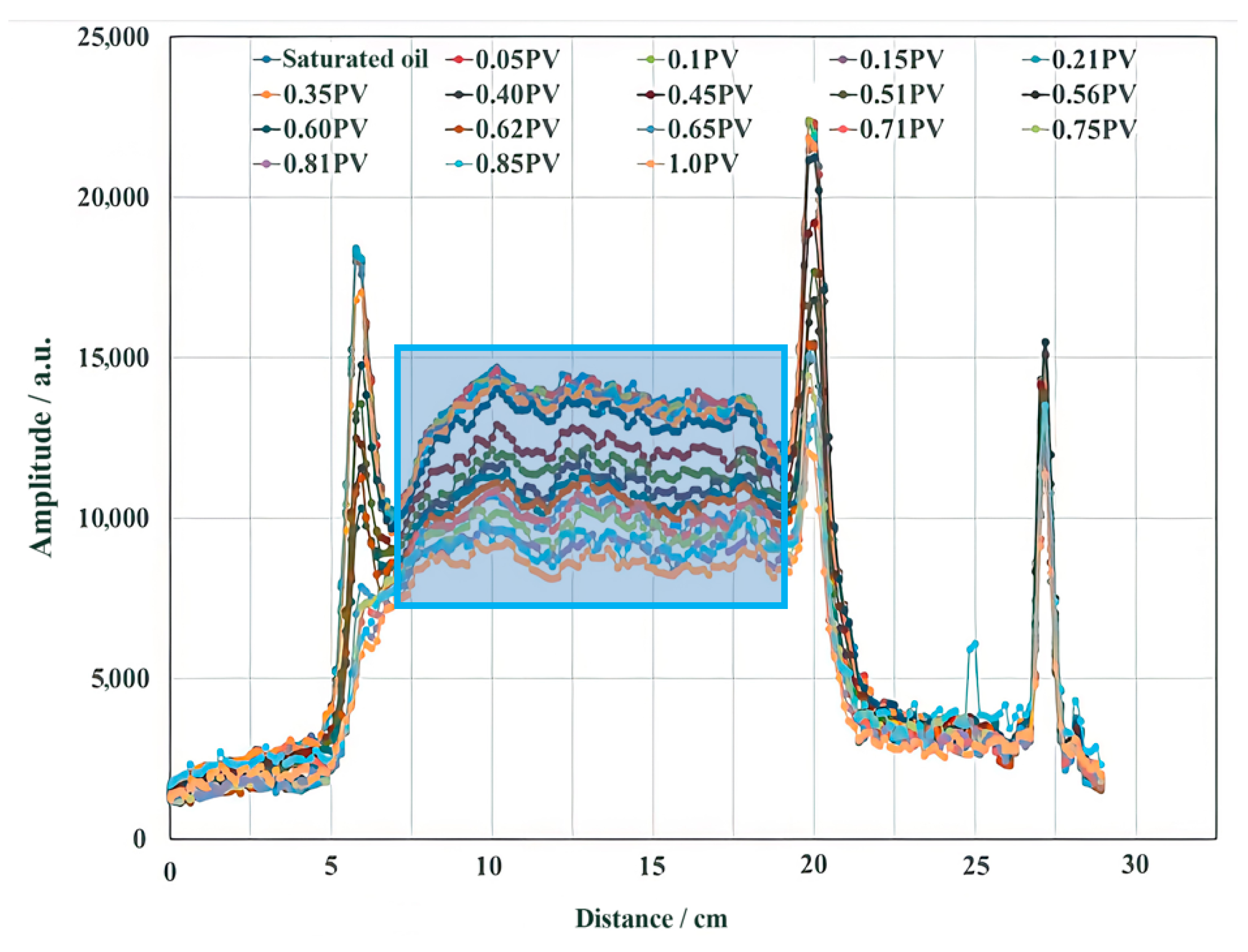

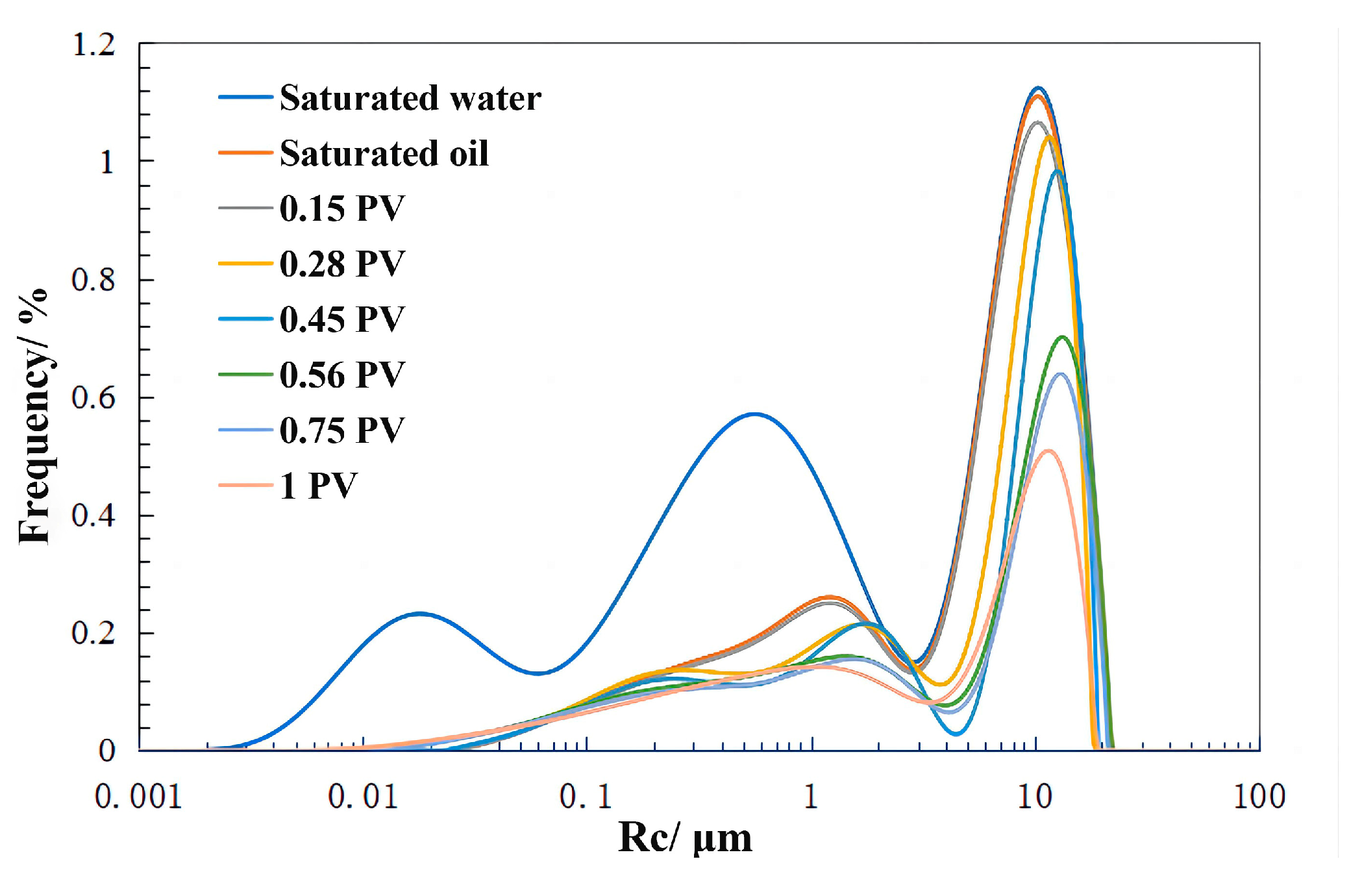
| Parameter | Value (Unit) | Parameter | Value (Unit) |
|---|---|---|---|
| Reservoir depth/m | 2400 | Crude oil volume factor | 1.309 |
| Original pressure/MPa | 31.59 | Viscosity/mPa·s | 7.5 (20 °C) |
| Present formation/MPa | 18.20 | Geothermal temperature/°C | 65.4 |
| Porosity/% | 11.50 | GOR | 118.0 |
| Permeability/mD | 18.31 | Relative density of natural gas | 0.732 |
| Wax content/% | 5.5 | Recovery percent of reserve/% | 11.8 |
| Number | Length/cm | Diameter/cm | Porosity/% | Permeability/mD |
|---|---|---|---|---|
| 1 | 5.700 | 3.641 | 11.22 | 28.2 |
| 2 | 5.040 | 3.786 | 13.94 | 15.7 |
| 3 | 6.402 | 3.645 | 14.63 | 25 |
| 4 | 7.302 | 3.795 | 15.32 | 12.5 |
| 5 | 6.910 | 3.801 | 16.50 | 16.4 |
| 6 | 5.152 | 3.795 | 14.09 | 20.9 |
| 7 | 7.686 | 3.665 | 13.85 | 29.5 |
| 8 | 6.952 | 3.752 | 14.98 | 18.6 |
| 9 | 5.865 | 3.845 | 15.86 | 20.8 |
| Parameter | Value | Parameter | Value |
|---|---|---|---|
| SF | 14.2 MHz | NECH | 4096 |
| P90 | 35 μs | NS | 32 |
| DW | 2 μs | RD | 3000 ms |
| Dead1 | 4 μs | TE | 130 μs |
| Dead2 | 6 μs | RG | 20 |
| SF (MRI) | 14.2 (MHz) | TR (MRI) | 400 ms |
| RG (MRI) | 40 | NEX (MRI) | 10 |
Disclaimer/Publisher’s Note: The statements, opinions and data contained in all publications are solely those of the individual author(s) and contributor(s) and not of MDPI and/or the editor(s). MDPI and/or the editor(s) disclaim responsibility for any injury to people or property resulting from any ideas, methods, instructions or products referred to in the content. |
© 2024 by the authors. Licensee MDPI, Basel, Switzerland. This article is an open access article distributed under the terms and conditions of the Creative Commons Attribution (CC BY) license (https://creativecommons.org/licenses/by/4.0/).
Share and Cite
Luo, Y.; Yang, S.; Zhang, Y.; Kou, G.; Zhao, S.; Zhao, X.; Zhang, X.; Chen, H.; Wang, X.; Xiao, Z.; et al. Characteristics and Mechanisms of CO2 Flooding with Varying Degrees of Miscibility in Reservoirs Composed of Low-Permeability Conglomerate Formations. Processes 2024, 12, 1203. https://doi.org/10.3390/pr12061203
Luo Y, Yang S, Zhang Y, Kou G, Zhao S, Zhao X, Zhang X, Chen H, Wang X, Xiao Z, et al. Characteristics and Mechanisms of CO2 Flooding with Varying Degrees of Miscibility in Reservoirs Composed of Low-Permeability Conglomerate Formations. Processes. 2024; 12(6):1203. https://doi.org/10.3390/pr12061203
Chicago/Turabian StyleLuo, Yun, Shenglai Yang, Yiqi Zhang, Gen Kou, Shuai Zhao, Xiangshang Zhao, Xing Zhang, Hao Chen, Xiuyu Wang, Zhipeng Xiao, and et al. 2024. "Characteristics and Mechanisms of CO2 Flooding with Varying Degrees of Miscibility in Reservoirs Composed of Low-Permeability Conglomerate Formations" Processes 12, no. 6: 1203. https://doi.org/10.3390/pr12061203
APA StyleLuo, Y., Yang, S., Zhang, Y., Kou, G., Zhao, S., Zhao, X., Zhang, X., Chen, H., Wang, X., Xiao, Z., & Bai, L. (2024). Characteristics and Mechanisms of CO2 Flooding with Varying Degrees of Miscibility in Reservoirs Composed of Low-Permeability Conglomerate Formations. Processes, 12(6), 1203. https://doi.org/10.3390/pr12061203








